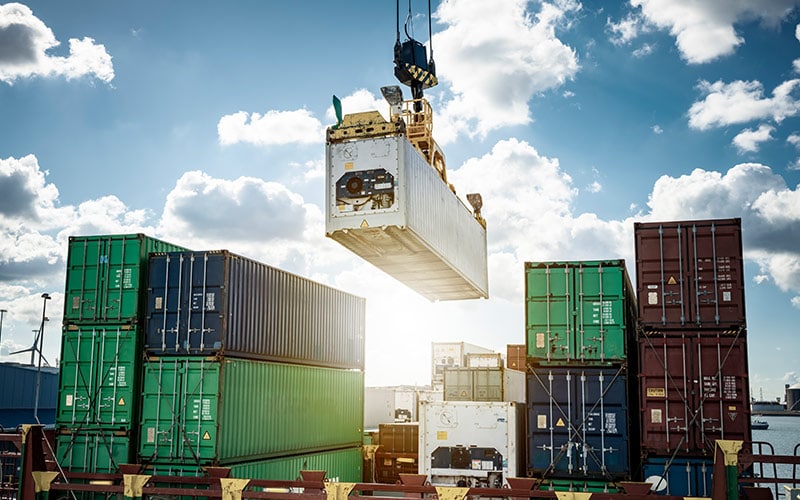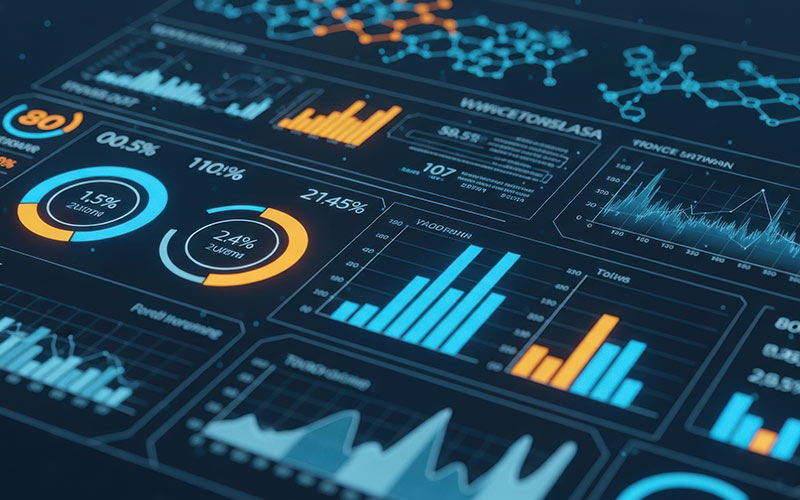Insights
- Unexpected supply chain disruptions can lead businesses to become less responsive to market demands, and suffer economic losses.
- Supply chain visibility, agility, and real-time collaboration can help mitigate these issues.
- A connected partner ecosystem – where partners in a supply chain exchange key information with each other in real time – can be a way for businesses to drive visibility and transparency in the supply chain.

Supply chain problems are far from ending. A CNBC survey shows that 29% of logistics managers are expecting supply chains operations to return to normal only in or after 2025 - or even never. Between issues ranging from cost increases related to raw materials, freight, labor, and manufacturing, to challenges caused by natural calamities and geopolitical crises, businesses have very little room for error. They must ensure to have as much visibility into their supply chains as possible to keep its disparate moving parts functioning smoothly. Investing in the right technology can help businesses develop a connected partner ecosystem and bring the visibility needed to keep the supply chains moving.
Current priorities for supply chains
When businesses are faced with unexpected supply chain disruptions beyond their control, it leads to delays, which in turn can snowball into the businesses becoming less responsive to market demands, and suffering economic losses in the process. Businesses have learned lessons from the shocks of the pandemic, the war in Ukraine and problems in the Red Sea, and have come to realize that what will help them bounce back during tough times and stand out among competition is supply chain agility, resilience, and business continuity for which visibility, along with standardized processes, is essential.
When IDC conducted a supply chain survey for more than 1,500 supply chain professionals including managers, leaders, VPs, and COOs, and asked them what their response to managing risk was, they replied it was supply chain visibility, agility, and real-time collaboration. This was also highlighted by Eric Thompson, research director - supply chain planning at IDC, who took part in a webinar by Infosys and EdgeVerve, on supply chains and connected partner ecosystems.

Unlocking the benefits
A connected partner ecosystem is a network where partners in a supply chain exchange key information with each other in real time for mutual benefit. Such visibility and transparency drives supply chain orchestration, to constantly rebalance inventories against demand thereby helping the participants in the supply chain be more agile and responsive.
Rahul Ubgade, assistant vice-president, consumer goods, retail, and logistics at Infosys, explained during the webinar how this can work for a business. “One of Infosys’s clients, a leading sports apparel brand, decided to not retail in an online marketplace, and instead opted to run their own online journey. Doing this in collaboration with their retailer partners, they enabled retailers with real-time visibility to brand inventory. This maximized the chances of a shopper finding a product regardless of the physical possession of such inventory i.e., the brand and the retailer.”

He added, “In the process, the shopper could also end up buying additional items, making it a win-win for all entities in the equation. This type of an ecosystem helps all partners collaborate in a way that consumer loyalty remains intact. This system helped the brand grow without the constraints of inventory. This is an example of how brands and retailers can leverage each other in a connected ecosystem and fulfill consumer demand.”
A study shows that companies that can be identified as supply chain leaders are those that place an emphasis on a self-orchestrated supply chain and integration between their partner ecosystem. Investments in these areas have been known to help companies achieve 6.8% savings in supply chain costs annually, as well as increase revenue by 7.7%. It is also helping them improve their customer satisfaction by increasing their on-time in-full delivery levels.
Investments in partner ecosystems can help companies achieve savings in supply chain costs and increase revenue.
Hurdles to jump
While developing a connected partner ecosystem can benefit companies in several ways, getting one in place is often a complex process. The biggest challenge lies in picking which partners to work with, as reliability is necessary for the partnership to work. All the partners need to be aligned on the vision of providing memorable experiences to the customer, and be committed to the cause. There is also a need for appropriate technology to support the necessary exchange of data between partners.
Once the ecosystem is in place, the next challenge is scaling the collaboration. Businesses could also have to harmonize their data and processes with their partners in order to streamline the ecosystem and make sure it works for everyone involved.
“When you are dealing with partners outside your enterprise, their maturity level – from a technology perspective and process perspective – could differ from yours,” said Suresh Bharadwaj, TradeEdge platform head at EdgeVerve.
He added: “At times, the partner might not want to collaborate, or they might not know how to go about it. The willingness to collaborate comes in when every partner stands to gain and there are business incentives for everyone. If you are the one seeking collaboration, you should communicate to the partner that you will be ensuring that there is minimum change and investment of time and effort on their part. We have noticed that every time there are mandates for collaborations, the collaborations tend to fizzle out, barring a few top partners.”
How to build connected partner ecosystems
-
Concept of shared wins
As collaboration between partners requires them to expose their data and processes to each other, trust between partners is key. Identifying the value in the goal for all partners concerned and articulating it at the start helps set the stage for collaboration. When partners view the goal as a shared win with mutual benefits, it motivates them to overcome hurdles and work more efficiently.Eric Thompson stressed the need for this: “I was leading teams that were planning across nine categories in 15 countries, so, you can imagine the data discrepancies and disparities involved. With some countries, we had only 20% to 30% of coverage across our retailers, and low visibility to even point of sale data. We were trying to build more predictive models and, in one case, tell someone that they were buying too much of our product, and tell the retailer to buy less because that will be more profitable for them, and we will have better inventory, and all of us will win.”
“We used that as a case to tell them to improve their data quality to match our standards, and challenge our downstream partners to up their game in terms of their data quality,” he added. “In some cases, we were meeting partners to say we wanted them to focus on profitability and we wanted us to do this together. At times you need to point out to your partners about the benefit of a shared inventory because if inventories become more productive, we are all going to be more profitable.”

-
Focus on recent data
Companies must have up-to-date data to achieve accurate demand forecasting: they can’t just rely on historical data. They should have clear visibility into weekly sales or daily sales. That real-time data will help them understand any stock issues, and which partners can help them fulfil an order. AI and generative AI can crunch data from disparate sources and help companies glean actionable insights.Companies must have up-to-date data to achieve accurate demand forecasting: they can’t just rely on historical data.
This is particularly important for CPG companies. They usually rely on their shipment information to forecast demand, but there is a lag of between four and six weeks between the shipment information and information related to what consumers offtake, that is, the sale from the retailer to the consumer. This leads to forecast errors with consequent stockouts or excess inventory situations.
Ubgade explained how Infosys has addressed this problem: “Infosys has partnered with some of the leading CPG companies globally to really work with them with their agreements on retail data. We have created a bridge directly with the retail companies to ingest and harmonize data, and now with generative AI, data is getting harmonized even faster. It is helping brands connect with partners within their ecosystem and use consumer optics to drive their supply chain trade, trade promotion planning, and media planning all related to real consumer demand rather than based on stale shipment information.”
-
Drive interoperability of data
Companies need to look beyond integration of data to emphasize interoperability of data. It means that the data being viewed by different partners needs to be harmonized so that it means the same thing to everyone. This can be done through an industry platform where there are defined canonical data models to drive the interoperability, which helps companies respond to issues in their ecosystems.Data being viewed by different partners needs to be harmonized so that it means the same thing to everyone.
Bharadwaj added: “It is also important for all the functions within the enterprise, whether it is sales, marketing supply chain, or even finance, to refer to the same version of truth. Each function has their own sources of data and therefore when the sales team is making their plans, they are using a different dataset compared to what the marketing team might be using. Therefore it is important to bring it all together in a centralized data service within the enterprise, so the reconciliations that happens through sales and operations planning processes today can be avoided if everyone can agree they are looking at the same data and understand it the same way.”
-
Leverage technology for collaboration
When speed is important, companies should use API-driven technology to get them the visibility they need into their networks without any latency. Brands can get their demand forecasting wrong at times. For example, when demand forecasting goes awry and stock is in the wrong place, companies must have the right technology to get visibility of partners’ inventories and communicate with their third-party logistics partners so that orders can be fulfilled, if necessary by moving stock to where it’s needed. All of this must happen in real time, including making sure the third-party logistics partner is playing their part. -
Lean on industry platforms
Rather than trying to build a partner ecosystem on their own, brands should use platforms to connect with and onboard their partners, advised Bharadwaj. “Using industry platforms allows companies to connect with and onboard multiple retailers and distributors on the platform and get immediate access to the data post data-sharing agreements with the partners. Companies can achieve value realization much faster, get the demand sensing in near-real time, if not real time, and gain better forecasting accuracy.” He added: “Some of our customers have realized almost up to 20% increase in forecast accuracy. They can go beyond their inventory, and if they do not have a product in stock, tap into their network to fulfil the order by means of having a bird’s eye view of the network.”
By relying on industry platforms to build sturdy partner ecosystems, ensuring mutually beneficial collaborations, and combining the benefits of high-quality, recent, and interoperable data, companies can enjoy all that connected partner ecosystems have to offer to drive responsiveness during challenging times, as well as profitability.






